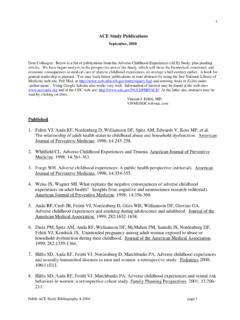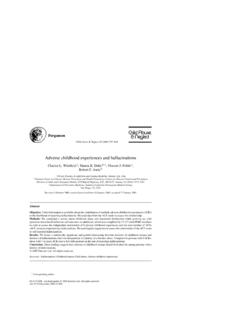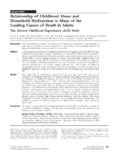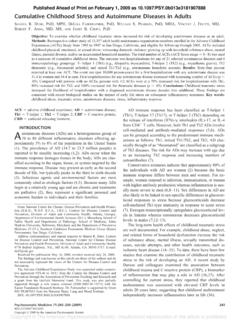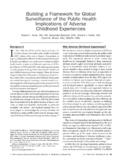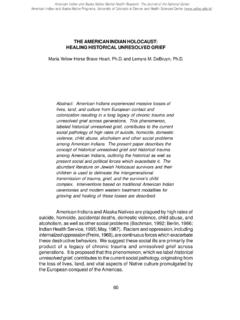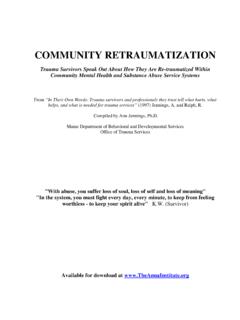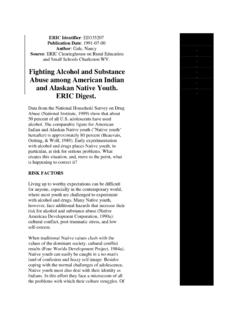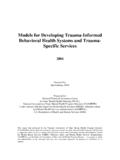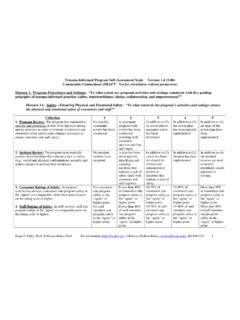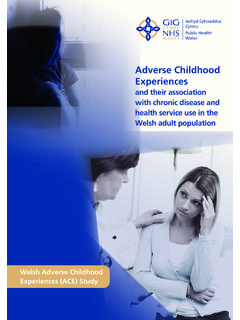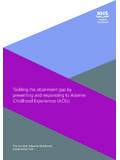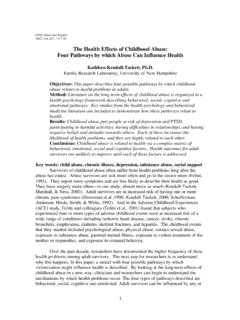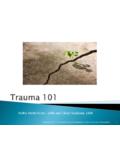Transcription of Adverse Childhood Experiences and Risk of …
1 Adverse Childhood Experiences and Risk of Paternityin Teen PregnancyRobert F. Anda,MD,MS, Daniel P. Chapman,PhD,MS, Vincent J. Felitti,MD,FACP,Valerie Edwards,PhD, David F. Williamson,PhD, Janet B. Croft,PhD, and Wayne H. Giles,MDOBJECTIVE:Few studies have investigated risk factors thatpredispose males to be involved in teen pregnancies. Toprovide new information on such factors, we examined therelationships of eight common Adverse Childhood experi-ences to a male s risk of impregnating a :We conducted a retrospective cohort study us-ing questionnaire responses from 7399 men who visited aprimary care clinic of a large health maintenance organi-zation in California.
2 Data included age of the youngestfemale ever impregnated; the man s own age at the time;his history of Childhood emotional, physical, or sexualabuse; having a battered mother; parental separation ordivorce; and having household members who were sub-stance abusers, mentally ill, or criminals. Odds ratios(ORs) for the risk of involvement in a teen pregnancy wereadjusted for age, race, and :At least one Adverse Childhood experience wasreported by 63% of participants, and 34% had at least twoadverse Childhood Experiences ; 19% of men had been in-volved in a teen pregnancy.
3 Each Adverse Childhood expe-rience was positively associated with impregnating a teen-ager, with ORs ranging from (sexual abuse) to (criminal in home). We found strong graded relationships(P<.001) between the number of Adverse childhoodexperiences and the risk of involvement in a teen preg-nancy for each of four birth cohorts during the last with males with no Adverse Childhood experi-ences, a male with at least five Adverse Childhood experi-ences had an OR of (95% confidence interval [CI] , ) for impregnating a teenager.
4 The magnitude of theORs for the Adverse Childhood Experiences was reduced64 100% by adjustment for potential intermediate vari-ables (age at first intercourse, number of sexual partners,having a sexually transmitted disease, and alcohol or drugabuse) that also exhibited a strong graded relationship toadverse Childhood : Adverse Childhood Experiences have an im-portant relationship to male involvement in teen preg-nancy. This relationship has persisted throughout foursuccessive birth cohorts dating back to 1900 1929, suggest-ing that the effects of Adverse Childhood Experiences tran-scend changing sexual mores and contraceptive to prevent teen pregnancy will likely benefit frompreventing Adverse Childhood Experiences and their associ-ated effects on male behaviors that might mediate theincreased risk of teen pregnancy.
5 (Obstet Gynecol 2002;100:37 45. 2002 by The American College of Obstetri-cians and Gynecologists.)Efforts to prevent teenage pregnancies1,2seldom focuson the male reducing the number of teenpregnancies is a national priority,4the scarcity of infor-mation about the male role presents an opportunity toinvestigate new avenues of prevention. In a retrospectivestudy of adolescent mothers, Taylor et al5identifieddemographic characteristics of adult men who impreg-nated a teenager. While providing an important descrip-tion, that study did not examine life Experiences thatpotentially increase the risk of male involvement in teenpregnancy.
6 Moreover, they identified risk factors distin-guishing only men aged 20 years or older at the time ofthe pregnancy, who were responsible for slightly lessthan half of the births of teenage mothers in their effects of Childhood abuse can provide insightinto behavioral pathways that lead to teen to their peers, adolescents who have been phys-ically or sexually abused or exposed to domestic violencehave more sexual partners and earlier ages at first inter-course,6 15are less likely to use contraception,16morelikely to use alcohol or drugs,6,17and to consume alcoholbefore of these behaviors could increase amale s risk of impregnating a teenage girl.
7 Notably,adolescent males involved in a teen pregnancy reporthaving more sexual partners, using condoms inconsis-tently or not at all, and higher rates of drug use andsexually transmitted diseases (STDs).18In previous in-vestigations, we found that the risks of alcoholism, drugFrom the National Center for Chronic Disease Prevention and Health Promotion,Centers for Disease Control and Prevention, Atlanta, Georgia; and Department ofPreventive Medicine, Southern California Permanente Medical Group (Kaiser-Permanente), San Diego, authors gratefully acknowledge the technical assistance of Naomi Adverse Childhood Experiences Study is currently funded by a grant from theGarfield Memorial 100, NO.
8 1, JULY 20020029-7844/02/$ 2002 by The American College of Obstetricians and Gynecologists. Published by Elsevier Science S0029-7844(02)02063-Xabuse, sexual promiscuity, STDs, and unintended preg-nancies increase as the number of Adverse childhoodexperiences increases19,20and that Adverse childhoodexperiences usually occur in clusters19 21and thusshould be studied as a set of Experiences rather investigation estimates the strength of the associ-ation between the following eight Adverse childhoodexperiences and the risk of male involvement in a teenpregnancy: emotional, physical, and sexual abuse.
9 Hav-ing a battered mother; parental separation or divorce;and growing up with a substance abusing, mentally ill, orcriminal household member. We chose these experi-ences because they are common and have deleteriouseffects on child ,20,23 27We assessed therelationship between Adverse Childhood Experiences andimpregnating a teenager among four birth cohorts ofmen to determine whether our findings apply to theexperiences of both younger and older males. In addi-tion, we examined the effect of sexual behaviors andsubstance abuse on the Adverse Childhood experience teen pregnancy relationship.
10 To better assess the impactof Adverse Childhood Experiences on a male s risk ofimpregnating a teenager during both adolescence andadulthood,28 30we report results separately for bothmales who were teenagers versus those who were morethan 20 years old at the time of their involvement in ateen AND METHODSData were collected at Kaiser Permanente s Health Ap-praisal Clinic in San Diego, California, where more than45,000 adult members undergo standardized examina-tions annually. A recent review of utilization recordsamong Kaiser members in San Diego who were enrolledcontinuously between 1992 and 1995 showed that 81%of those aged 25 years and older had been evaluated atthe Health Appraisal Clinic.
